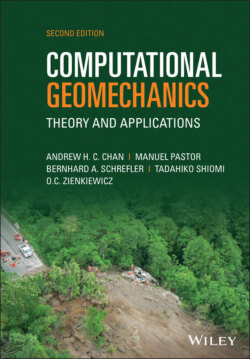Читать книгу Computational Geomechanics - Manuel Pastor - Страница 22
2.2.3 Limits of Validity of the Various Approximations
ОглавлениеIt is, of course, important to know the degree of approximation involved in various differential equation systems. Thus, it is of interest to know under what circumstances undrained conditions can be assumed, to define the behavior of the material and when the simplified equation system discussed in the previous section is applicable, without introducing serious error. An attempt to answer these problems was made by Zienkiewicz et al. (1980). The basis was the consideration of a one‐dimensional set of linearized equations of the full systems (2.11), (2.13), and (2.16) and of the approximations (2.20) and (2.21). The limiting case in which wi,i = 0 (representing undrained conditions) was also considered.
Table 2.1 Comparative sets of coupled equations governing deformation and flow.
| u − w − p equations (exact) [(2.11), (2.13), and (2.16)] |
| u − p approximation for dynamics of lower frequencies. Exact for consolidation [(2.20), (2.21)] |
| u − U, only convective terms neglected (3.72) |
| In all the above |
| σ″ = σ + αm p and dσ″ = D dε = DS du |
For all these conditions, the exact solution of the equation is possible. We consider thus that the only physical variation is in the vertical, x1, direction (x1 = x) and then we have
where D is called the one‐dimensional constrained modulus, E is Young’s modulus and ν is Poisson’s ratio of the linear elastic soil matrix, also
The differential equations are, in place of (2.11):
In place of (2.13):
and in place of (2.16):
with
Taking Ks → ∞
For a periodic applied surface load
a periodic solution arises after the dissipation of the initial transient in the form
and a system of ordinary linear differential equations is obtained in the frequency domain which can be readily solved by standard procedure.
The boundary conditions imposed are as shown in Figure 2.1. Thus, at x = L, u = 0, w = 0, and at x = 0, σx = q, p = 0.
In Figure 2.1 (taken from Zienkiewicz et al. (1980)), we show a comparison of various numerical results obtained by various approximations:
1 exact solution (Biot’s, labelled B)
2 the u−p equation approximation (labelled Z)
3 the undrained assumption (w = 0) and
4 the consolidation equation obtained by omitting all acceleration terms (labelled C).
The reader will note that the results are plotted against two nondimensional coefficients:
where k′ and k are the two definitions of permeability discussed earlier.
In the above
where L is a typical length such as the length of the one‐dimensional soil column under consideration, g is the gravitational acceleration,
is the speed of sound, is the natural vibration period and T is the period of excitation.
The second nondimensional parameter is defined as
Figure 2.1 The soil column – variation of pore pressure with depth for various values of π1 and π2 –––– B (Biot theory) – – – – Z (u–p approximation theory) ––C (Consolidation theory) (Solution (C) is independent of π2).
Source: Reproduced from Zienkiewicz et al. (1980) by permission of the Institution of Civil Engineers.
(a) π2 ≤ 10−3. (b) π2 = 10−2. (c) π2 = 10−1. (d) π2 = 100. (e) π2 = 101. (f) π1 = 10−1 π2 = 102. Reproduced from Zienkiewicz (1980) by permission of the Institution of Civil Engineers.
In the study, the following values were assumed:
and
Figure 2.2 Zones of sufficient accuracy for various approximations: Zone 1, B = Z = C, slow phenomena ( and ü can be neglected); Zone 2, B = Z ≠ C, moderate speed ( can be neglected); Zone 3, B ≠ Z ≠ C, fast phenomena ( cannot be neglected, only full Biot equation valid)
Figure 2.2 summarizes the conclusions by indicating three zones in which various approximations are sufficiently accurate.
We note that, for instance, fully undrained behavior is applicable when Π1 < 10−2 and when Π1 > 102, the drainage is so free that fully drained condition can be safely assumed.
To apply this table in practical cases, some numerical values are necessary. Consider, for instance, the problem of the earthquake response of a dam in which the typical length is characterized by the height L = 50 m, subject to an earthquake in which the important frequencies lie in the range
Thus, with the wave speed taken as
we have
the parameter Π2 is, therefore, in the range 3.9 × 10−3 < Π2 < 39
and Π1 is dependent on the permeability k with the range defined by
According to Figure 2.2, we can, with reasonable confidence:
1 assume fully undrained behavior when Π1 = 97k′ < 10−2 or the permeability k′ < 10−4 m/s.
2 We can assume u–p approximation as being valid when k′ < 10−3 m/s to reproduce the complete frequency range. However, when k′ < 10−1 m/s, periods of less than 0.5 seconds are still well modeled.
We shall, therefore, typically use the u–p formulation appropriately in what follows reserving the full form for explicit transients where shocks and very high frequency are involved.
